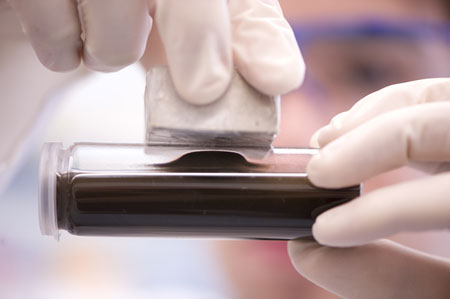| Mar 20, 2014 |
Recovering valuable substances from wastewater
|
|
(Nanowerk News) Phosphorus can be found in fertilizers, drinks and detergents. It accumulates in waterways and pollutes them. For this reason the German Phosphorus Platform has the goal to recover this valuable, but at the same time, harmful element from water. How this can be done will be shown by researchers at the Hannover Trade Fair / IndustrialGreenTec from April 7 – 11 in Hannover (hall 6, booth J18) where visitors can try out the method for themselves.
|
|
Not only plants, but also humans and animals need phosphorus, which is a building block of DNA. Many biological processes in our body can only take place if phosphorus atoms are also present. But farmers and industrial enterprises use so much of this element that soil is over-fertilized and waterways are contaminated.
|
 |
| Using magnets the superparamagnetic particles in the water can be removed along with their phosphorus load.
|
|
This is where the experts of the German Phosphorus Platform DPP come in. As they have made it their aim to recover the phosphorus from the water, on the one hand in order to protect the environment and on the other to reutilize this valuable raw material so that no new phosphorus has to be taken from the deposit sites because phosphorus is getting more and more scarce. Although these sites still have enough phosphorus for the next 250 years, very few countries export this element so that if the geopolitical situation were to be become volatile, this would be bad news for supplies. Another problem is that in many mining areas the phosphorus deposits are contaminated with heavy metals. Unfortunately industry is heavily reliant on phosphorus, not just the food and drinks industry, but also the building material and detergents industries as well as semiconductor and lighting manufacturers.
|
|
The German Phosphorus Platform was established in November 2013 and operates under the umbrella of the Fraunhofer Project Group Materials Recycling and Resource Strategies IWKS of the Fraunhofer Institute for Silicate Research ISC. “The German Phosphorus Platform is the network for phosphorus” explains Prof. Stefan Gaeth, Executive Manager of the DPP. “It attempts to bring together all the key players who use, recover and need phosphorus around one table”.
|
|
Trapping phosphorus with magnets
|
|
But how can phosphorus be recovered from water? Researchers at the IWKS have come up with an answer. “We add superparamagnetic particles to the water”, says Dr. Carsten Gellermann, head of business unit “Slags, sludges, landfill” at the IWKS. This means that if these particles detect a magnetic field they themselves become magnetic. However, if the magnet is removed the particles lose their magnetic property and float freely in the water without adhering to each other.
|
|
Researchers have attached bonding sites for phosphorus to these particles so that they fish the phosphate anions out of the water and carry them “piggyback”. Using a magnet the particles, along with their phosphorus load, can then be removed from the water, leaving the water clear of phosphorus. “This way other hazardous substances, such as toxic heavy metals, can also be removed relatively easily with magnets” explains Gellermann. For their technology the researchers, together with their colleagues from the Institute for Sanitary Engineering, Water Quality and Solid Waste Management ISWA at the University of Stuttgart, won the Re-Water Braunschweig Future Award worth €10,000 in December 2013. They will be presenting their technology and the German Phosphorus Platform at the Industrial-Greentech Trade Fair, a subsidiary of the Hannover Trade Fair from April 7 – 11 in Hannover (hall 6, booth J18).
|

